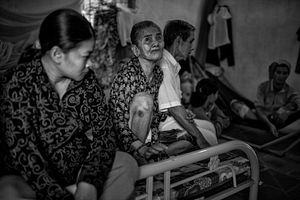Luc Forsyth and Gareth Bright have set out on a journey to follow the Mekong river from sea to source. The Diplomat will be sharing some of the stories they’ve found along the way. For more about the project, check out the whole series here.
When it became clear the boat was going to crash into us, it was too late to do anything but grip the ferry’s guardrails tightly and exchange a few fleeting looks of disbelief with Gareth. Had there been more time, our translator Mi, who could not swim, may have had the chance to look suitably terrified. But as it was she was barely able to fix her face with a look of mild surprise. Pablo, who held the dubious distinction of being the only member of our team to have been involved in the sinking of a boat, had already returned to Phnom Penh to start editing the footage he had shot. With him gone, Gareth and I assumed we would be safe from nautical disasters. But as the much larger vessel bore down on us, we knew we had been mistaken.
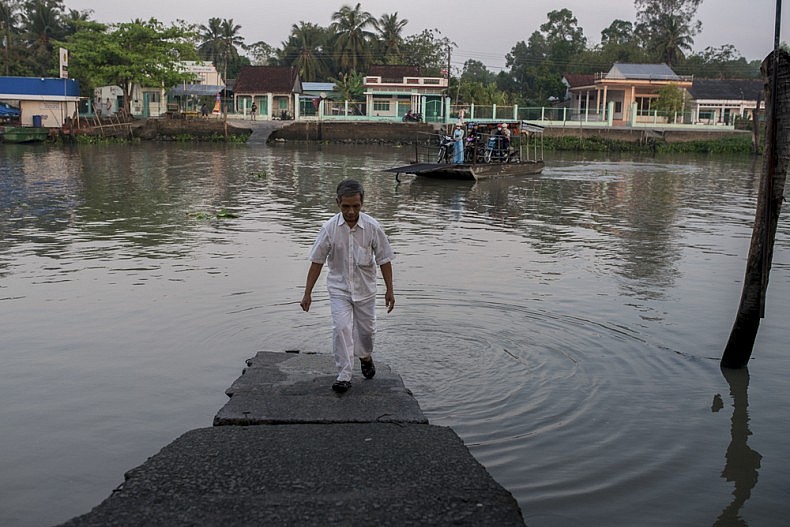
Dan, a follower of the Cao Dai religion, walks up a ferry jetty on his way to visit his ailing sister on the outskirts of Can Tho. Photo by Luc Forsyth.
Ten meters, five meters, one meter; the closer the ships came to each other, the more unreal the situation seemed. From the bow of the approaching vessel, a sturdy looking woman shrieked curses at the pilot of our ferry — until the moment she was drowned out by the concussive thud of hull-to-hull contact and the ensuing groans as the ferry’s metal canopy twisted and warped. As the woman continued to hurl obscenities, working frantically to separate the ships, I glanced back at the driver of our ferry to see a mask of absolute calm on his face. He hadn’t even stood up from the hammock he used as a captain’s chair, a half-smoked cigarette still dangling from the corner of his mouth.
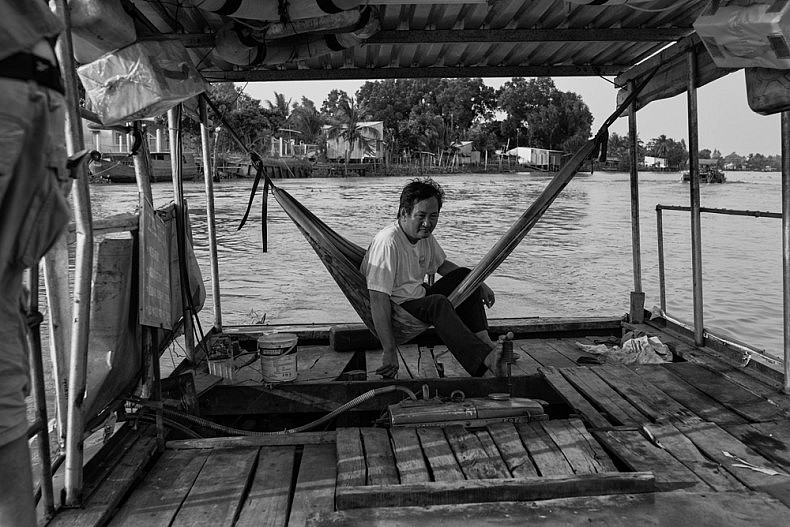
A ferry driver sits in his make shift hammock as he navigates one of the many canals that divide and connect the Mekong Delta. Ferries are used as transport throughout the Mekong Delta Region, a maze of small canals, rivers and arroyos interspersed with villages and floating markets. Photo by Gareth Bright.
Safely on the shore ten minutes later, we pieced together the sequence of events. The ferry captain, who successfully navigated the five minute river crossing at least a hundred times a day, had been so distracted by the presence of two foreigners in his sleepy community that he’d taken his eyes off the waterway to watch us. Not paying attention to the river traffic, he had taken us straight into the path of an oncoming boat.
I would have felt badly for the man had he not looked so utterly unconcerned. Considering the incident had been completely his fault, he managed to maintain an air of utmost dignity as he received new passengers. Without another glance in our direction, he spun his boat around and set off again for the opposite bank, head held high.
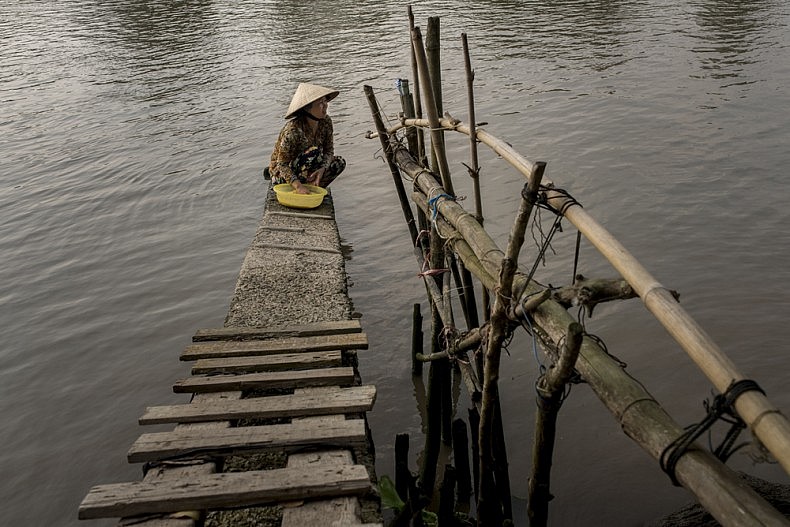
A woman washes clothes in a canal which is fed by the Mekong on the outskirts of Can Tho. The widespread use of agrochemicals has made much of the area’s water unfit for cooking and drinking, and locals report suffering skin rashes after coming into contact with it. However, many who cannot afford the premiums for clean water are forced to use river water despite the health risks. Photo by Luc Forsyth.
“What just happened?” Gareth asked no one in particular.
We had come to the village of Tan Thanh on the outskirts of Can Tho to try and gain insight into the relationship between the Mekong and Vietnam’s rural poor; a boat crash had not been part of the day’s agenda.
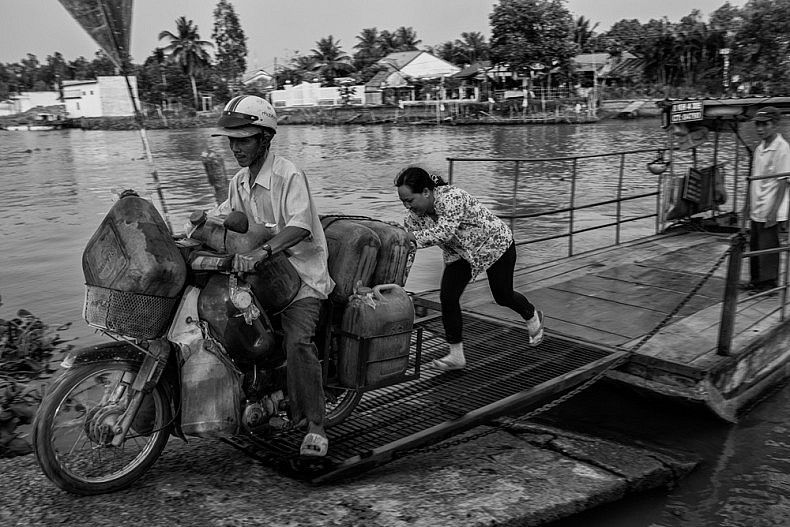
Ferries are used as transport throughout the Mekong Delta. Photo by Gareth Bright.
Looking for Light
Huynh Thi Ba was 81 years old and completely blind. Though her left eye retained some of its original dark brown color, the right was completely clouded by an eerily vibrant blue cataract. When we entered her bedroom she seemed to sense our presence, reaching a skeletal hand towards the shadows we cast over the room. Taking her hands in turn, Gareth and I attempted to greet her, but it was obvious she was almost totally deaf as well. Yet she seemed pleased by the human touch and spent several minutes tracing her leathered fingers over our hands and forearms, confused in equal measure by both our digital watches and foreign arm hair. When she reached our faces, heavily bearded after two weeks of travel, she drew back and barked a question that needed no translation: What is this?
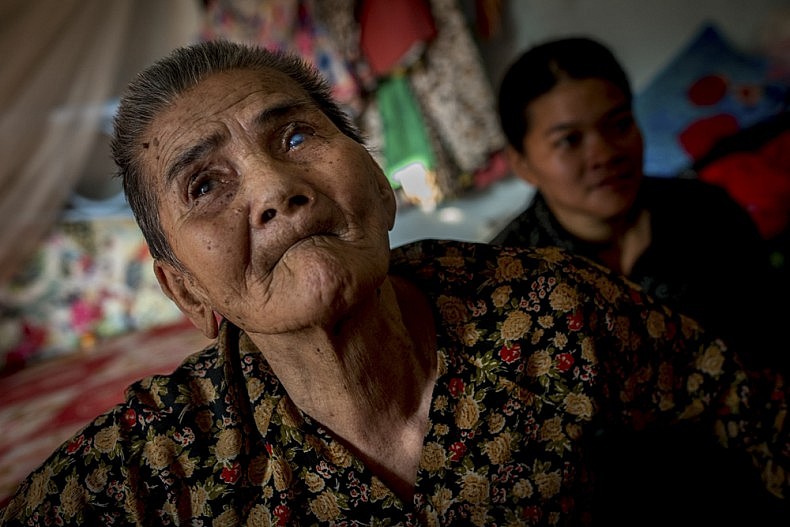
Ba, 84, is blind in both eyes and has not seen anything for 5 years. Photo by Luc Forsyth.
Ba’s younger brother Dan had brought us to the home when we’d asked him if he knew of any people in the area who struggled to find reliable access to clean water. A follower of the monotheistic Cao Dai religion who had returned to live in the faith’s nearby temple so he could be close to his ailing sister, Dan’s kindly face belied the strong emotions he must have felt at the sight of Ba’s feebleness. Through his family we learned just how precarious water security could be, even in the heart of the Mekong delta where water seemed most abundant.
“Before the water was better. I don’t remember when exactly, when they started harvesting rice three time a year [instead of once] they had to use a lot of chemicals and fertilizers, which made the water unfit to use,” Ba’s 49-year-old daughter Mung told us. We had spent the last few days in rural communities and had already learned that the widespread use of agrochemicals was seriously affecting the quality of the river water. But this particular situation was more dire than anything we had previously encountered.
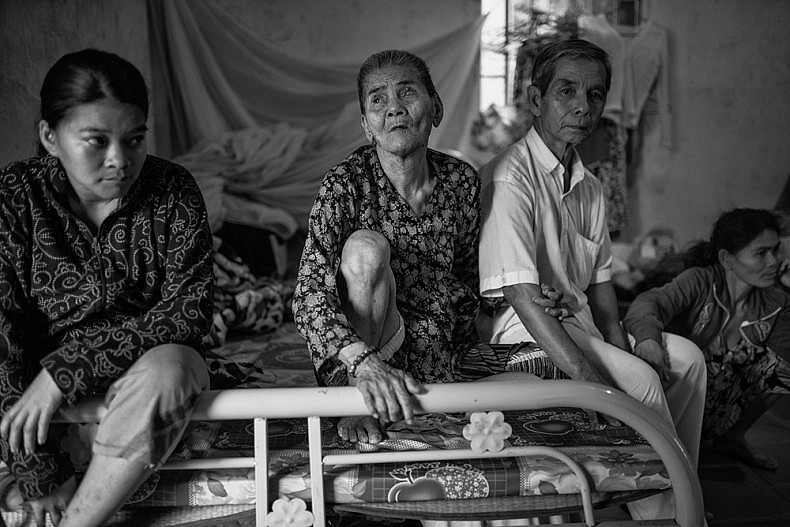
Mung and her family live in a small home outside Can Tho, donated by a local religious temple. Photo by Gareth Bright.
Fifteen years ago, the family — Ba, Mung, and Mung’s 25-year-old daughter Mit — had been laborers for hire, living in a tent and drifting from farm to farm in search of piecework. With the introduction of industrial fertilizers, herbicides, and pesticides, however, rice cultivation required far fewer workers per hectare. As a result, Mung had not found regular employment for 15 years. At roughly the same time, Ba, who had gathered taro leaves that Vietnamese traditionally used as food packaging, had been made obsolete by the introduction of plastic bags: “Before the era of plastic, we used leaves for bags,” Mung told us, “but when plastic came, [my mother] lost this job.” Shortly afterwards, she went blind.
Though the Cao Dai temple that Dan belonged to had recognized the family’s plight and donated enough money to replace their tent with a small cement structure, the situation remained desperate. With all three members of the household unable to earn income, Mung and Mit turned to scavenging for tin cans, which they could sell to local recycling facilities for a small profit. This required both women to be out of the house for long stretches of time, leaving Ba to fend for herself in her own personal darkness.
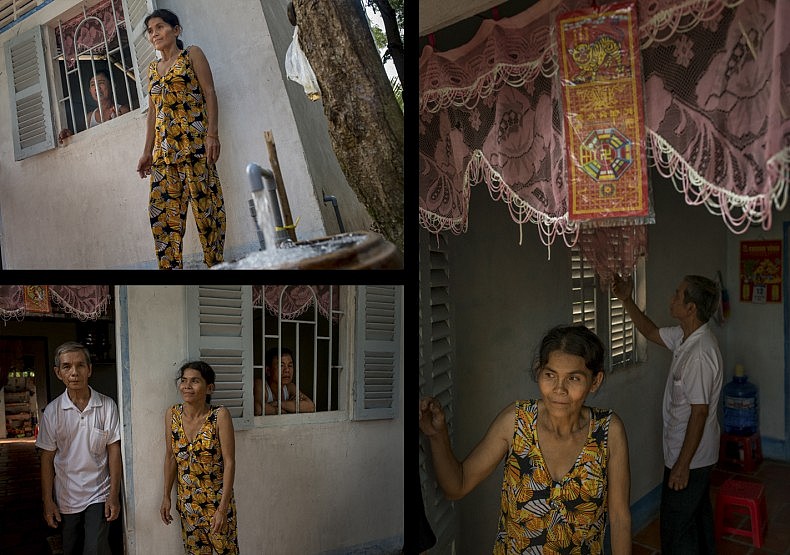
Mung, 49, and her uncle Dan stand in front of their family home. Photos by Luc Forsyth.
Levels of Purity
Despite their extreme poverty, food was not the most serious problem for Ba’s family. The Cao Dai temple donated rice periodically and neighbors pitched in vegetables when they couldn’t afford to buy enough. Ultimately it was clean water — or the lack thereof — that presented the biggest challenge to their health.
“We’re not afraid of the dirt,” Mung said of the Mekong tributary that flowed past their house, “the dirt is natural. It is the chemicals [that are a problem]. A few months ago I tried to take a bath in the river and I got a rash.” When we asked her why she thought the water affected her skin so badly, she again referred to the increased use of agricultural chemicals over the last two decades.
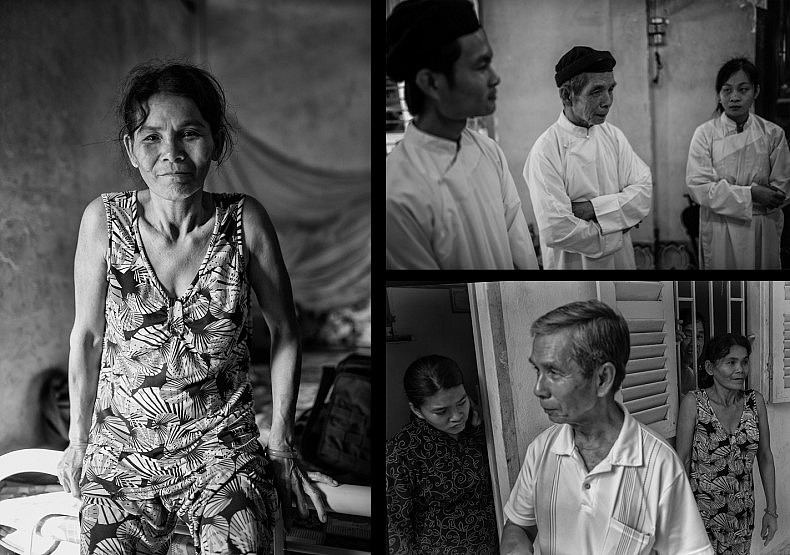
Mung, 49, and her uncle Dan stand in front of their family home. Photo by Gareth Bright.
Mung ranked water quality by sorting it into four categories. The highest quality (bottled and treated) was exclusively for drinking — but the prohibitively high price meant that the family could not afford to buy it regularly. One level down was piped water, which, while not as pure as bottled water, was of a quality high enough for drinking and cooking. Unfortunately, the pipes required for access to such water were not connected to their house, and the $100 price tag for installation was well beyond their means. Next was well water, which was technically deemed fit for drinking and cooking, but still contained too many pollutants to be considered healthy. In theory the family had access to a well where the government had installed a pump and tap on their property a year before, but Mung said it was often broken and that it could take weeks for a repairman to make it to their house. Lastly was the river water — judged unfit for anything other than washing clothes and dishes.
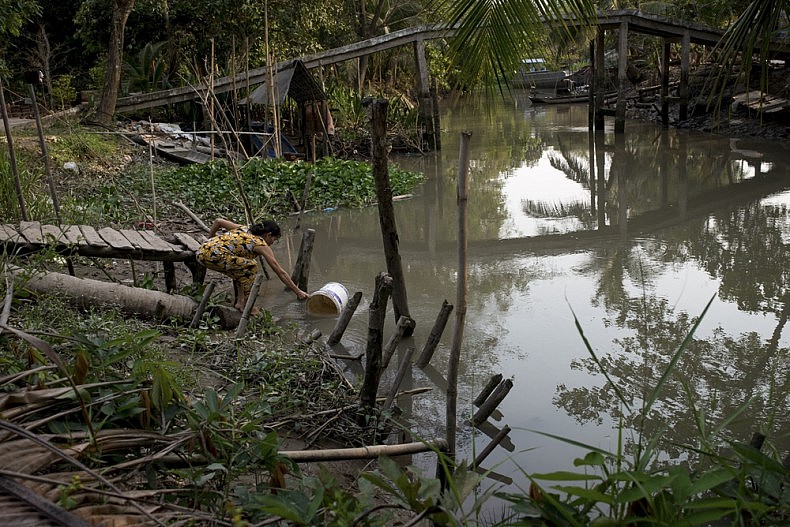
Mung, 49, fetches water from the Mekong. The family is too poor to consistently afford purified water and often must rely on chemical laden river water from the Mekong — resulting in multiple ailments from stomach viruses to headaches to skin rashes. Photo by Luc Forsyth.
Yet though Mung knew water from the river was dangerously laden with chemicals, for most of the year she had no choice but to use it. Judging by the rashes, headaches, and stomach problems Mung told us her family often suffered from, their domestic use of the river’s water was taking a toll. And, she said, it was not just humans that were being impacted.
“There used to be so many fish that you could catch them with your bare hands,” Mung said. “Now, even with modern equipment, you can’t find any fish.” Though she was perhaps exaggerating slightly, the conspicuous lack of fishing related activity in such a rural area suggested that she was right: the river was profoundly unhealthy.
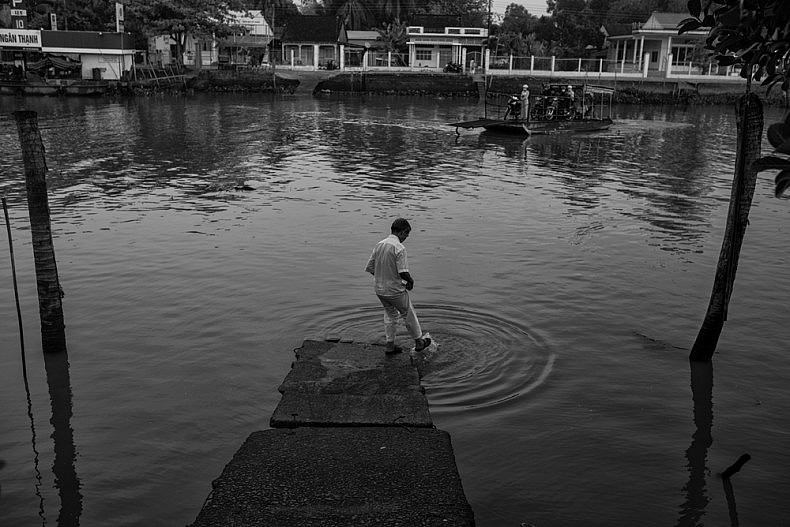
Dan on the jetty near his sister’s home. Photo by Gareth Bright.
How many other families in the area were using contaminated water for their daily needs, we wondered? If this was happening here, it stood to reason that it was happening elsewhere as well. How many people along the Mekong were being poisoned by the very river that had sustained life in Southeast Asia for millennia?
With these heavy questions looming large in our thoughts, we said goodbye to Mung and her family to board the ferry that would shuttle us back towards Can Tho. Thankfully, this time, the captain kept his eyes on the water.
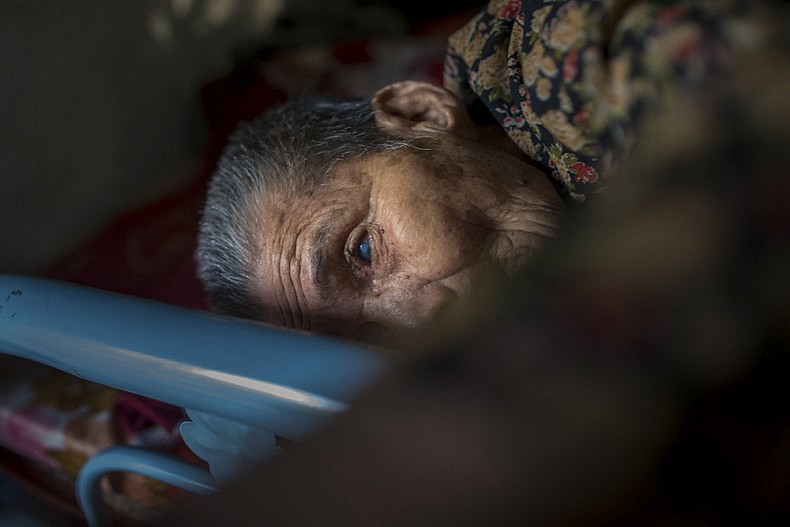
Ba, 84, lies in her family home. She’s been blind for five years. Photo by Luc Forsyth.
This piece originally appeared at A River’s Tail.













